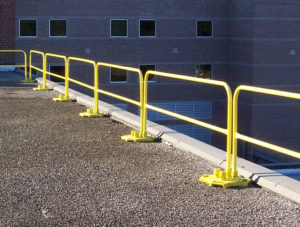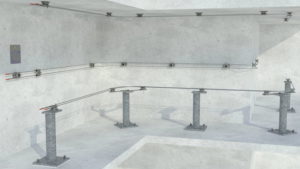If you’re a safety manager, keeping your employees healthy and safe is a top priority. To serve that purpose (and to avoid hefty fines), staying compliant with the OSHA regulations on fall protection should be a top priority, especially on commercial rooftops. Fortunately, there are several OSHA-approved solutions available that make staying compliant simple. Since each situation is different, your fall protection system needs to match your individual requirements. Let’s take a look at the two main ways to keep your team out of harm’s way and how you can choose the right system for the job.

Safety guard rails are precisely what they sound like: a railing system that creates a barrier from the leading edge of your rooftop. They are a form of passive fall protection — that means they prevent a fall from ever happening. They can also be used on steps, landings, platforms, around skylights and hatches, mezzanines, and other elevated surfaces. Depending on the kind you choose to install this type of fall protection system, they can be a temporary or permanent solution.
 Horizontal lifelines (HLL) are a form of active fall protection. That means they stop a fall as it occurs by arresting or restraining the user before they reach the surface below. They include a safety harness system and a cable attached to two or more anchor points. Those who use horizontal lifelines must be thoroughly trained in how to assemble, inspect, put on, and use the system. Furthermore, users must inspect the components for wear and tear before each and every use. All elements of the system must meet installation and load requirements of IBC and OSHA standards to ensure safety.
Horizontal lifelines (HLL) are a form of active fall protection. That means they stop a fall as it occurs by arresting or restraining the user before they reach the surface below. They include a safety harness system and a cable attached to two or more anchor points. Those who use horizontal lifelines must be thoroughly trained in how to assemble, inspect, put on, and use the system. Furthermore, users must inspect the components for wear and tear before each and every use. All elements of the system must meet installation and load requirements of IBC and OSHA standards to ensure safety.
Each of these systems has advantages for certain applications. Understanding their respective benefits allows safety managers to choose the fall protection system best suited for the job or environment.
Safety guard rails provide all-around safety, and for many reasons, are often the best general system for meeting fall protection requirements. Here are some situations where guard rails make the best choice:
The advantages of safety guard rails include:
While a great general solution, safety guard rails aren’t always the right choice for your fall protection environments of objectives. When it comes to cost-effectiveness and performance efficiency, sometimes lifelines are the way to go.
Horizontal lifelines are often a good choice for situations or circumstances where passive barriers don’t provide adequate safety, or simply aren’t cost-effective. Situations where HLL systems better accommodate fall protection objectives might include:
The advantages gained by the installation of horizontal lifelines include:
Regardless of which system you choose, it must comply with fall protection regulations set forth by OSHA. There are five general standards provided by OSHA when it comes to fall protection. Here is a brief list of what you can expect to learn about:
Remember, proper compliance in fall protection and prevention must meet or exceed the standards outlined by OSHA.
An adequate fall protection system is not just a regulatory requirement, but something that any responsible organization should provide for the safety of employees and/or visitors to their facility. When choosing your system, whether safety guard rails or horizontal lifelines, it helps to speak with a professional team that can help assess your needs. At Blue Water Manufacturing, safety is our business. Give us a call and we’ll help you get the right fall protection system for the job at hand.